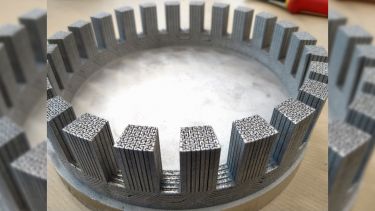Demand for electric motors is rapidly growing and these innovations are crucial to pioneering the next phases of transportation electrification, for example for aeroplanes, where batteries will need to be lighter and motors will need to be more energy powerful.
Sheffield researchers, working with collaborators at the University of Wisconsin-Madison (UW-Madison), have successfully developed an electric motor, using 3D printing technology (also known as additive manufacturing), paving the way for future electric motors to increase their power using less material.
The prototype, which uses a higher-percentage silicon electrical steel that reduces energy losses, was designed as part of a collaboration between Alexander Goodall, a doctoral student in the Department of Materials Science and Engineering; UW-Madison post-doctoral research assistant FNU Nishanth and and their advisers, Professor Iain Todd and Eric Severson.
The prototype design consists of a stator, a circular-shaped object with prongs that wires can be wrapped around to create a magnetic field. The biggest design difference between the prototype and traditional stators can be seen in the prongs themselves, as they feature an intricate design of thin geometric lines meant to reduce energy loss.
The collaboration was initiated by Alexander when he met Nishanth at a conference in 2020 and realised they had what the other needed to realise this project: Sheffield had access to the printing technology to make UW-Madison’s knowledge in creating unconventional motors a reality.
Alexander Goodall at the University of Sheffield came up with the concept, designed, developed and manufactured the stator, whilst researchers at the University of Wisconsin completed comprehensive testing, showing an improvement in torque density.
When the printed prototype was tested in October 2022, it was found that it was giving more torque than they thought was possible with less material. “When you have 30% lower mass, you would expect that your torque would also be lower ... but that wasn’t the case,” Nishanth said. “So, this shows that you know you’re actually going to net torque density improvement in this machine and if we can further improve this, (making a more efficient motor) would be a game changer.”
Traditional methods of creating stators in electric motors use a lamination process, where sheets of electrical steel are stamped out. What you get as a result is a stator stacked with the laminations with tiny but visible ridge lines on the top of the prongs.
That method, though easily replicated, tends to rely on using an electrical steel alloy with 3% silicon in it, which lends to higher rates of energy loss and less efficiency. An electrical steel alloy made with 6.5% silicon, recommended by the U.S. Department of Energy, reduces energy losses but is more brittle and is less likely to withstand the traditional lamination process.
But with 3D printing, there’s no need for tons of pressure to be exerted during rolling and the machine can print the delicate pattern on the small 10-kilowatt prototype stator within 20 hours. While that wouldn’t be enough energy to run an electric vehicle, the model could be easily scaled up to reach 40 kilowatts and printed faster on an industrial printer.
Alexander said: "This project has shown the large potential that additive manufacturing has for electrical machines, with lightweight, efficient structures that have never before been possible using any other manufacturing technique. It was a pleasure to work with the team at WEMPEC (an internationally renowned power electronics research and electric machines research group located at UW-Madison) to turn this idea into a reality"

